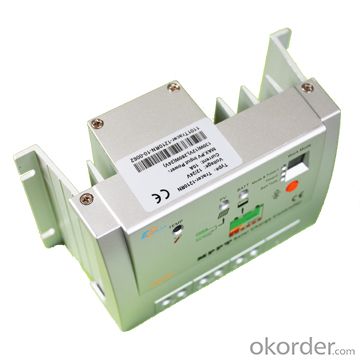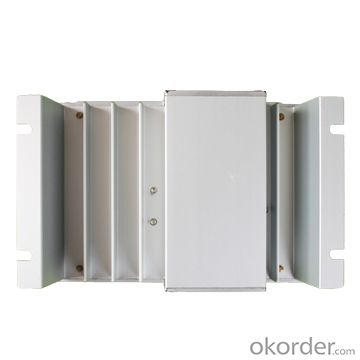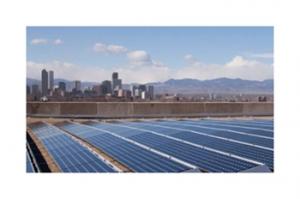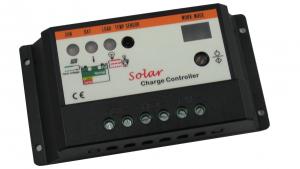Go Power Solar Charge Controllers MPPT Solar Charge Controller 10A 12/24V Tracer-1215RN
OKorder Service Pledge
OKorder Financial Service
You Might Also Like
All of our grid-tie inverters are UL listed and code-compliant. We do not stock refurbished grid-tie inverters.
Because grid-tie inverters have stricter requirements than off grid inverters, refurbished grid-tie inverters may not be code-compliant.
Check with your local electrician or building department before investing in a refurbished grid-tie inverter.



Specifications
MPPT controller
10A,12V/24V
Max PV input power 130W in 12V system, 260W in 24V system
ON/OFF, Dusk to dawn, 1-15h timer
Features:
· MPPT technology
· Peak conversion efficiency of 97 %
· High Tracking efficiency of 99%
· Several seconds tracking speed
· Very fast Sweeping of the entire I-V curve
· 4- Stage charge with PWM output
· Excellent thermal design and nature air cooling
· Full power output in ambient temperatures up to 45°C
· Temperature compensation function
· Sealed, Gel, Flooded battery type optional
· Diversified load control: Manual, Dusk to Dawn, dual timer, TEST
· RJ45 interface with optional remote meter
· Standard 2 years warranty
· CE certificate
Electronic Protections:
·PV short circuit protection
·PV reverse polarity protection
·PV overvoltage alarm protection
·PV over current protection
·Battery overcharge protection
·Battery over discharge protection
·Battery reverse polarity protection
·Load short circuit protection
·Load overload protection
Specification:
Model | Tracer-1210RN | Tracer-1215RN |
Rated system voltage | 12/24V auto work | |
Rated battery current | 10A | |
Rated load current | 10A | |
Max.battery voltage | 32V | |
Max.PV open circuit voltage | 100VDC | 150VDC |
Max.PV input power | 12V 130W; 24V 260W | |
Self-consumption | <10mA(24V) | |
Charge Circuit Voltage Drop | ≤0.26V | |
Discharge Circuit Voltage Drop | ≤0.15V | |
Communication | TTL232 / 8 pin RJ45 | |
Temp.compensation | -5mV/℃/2V | |
Working temperature | -35℃~+55℃ | |
Storage temperature range | -35℃~+80℃ | |
Humidity | 10%-90% NC | |
Enclosure | IP30 | |
Altitude | ≤3000m | |
Dimension | 156mm x 97mm x 68mm | |
Mounting holes | 147mm x 60mm | |
Mounting hole size | Φ5 | |
Terminal | 4mm2 | |
Weight | 0.55kg | |
- Q: What is the maximum current capacity of a solar controller?
- The maximum current capacity of a solar controller can vary depending on its specifications and model. However, in general, solar controllers are available in a range of current capacities, typically ranging from 10 amps to 60 amps or even higher for larger systems.
- Q: Can a solar controller be used with solar-powered electric fences for wildlife conservation?
- Yes, a solar controller can be used with solar-powered electric fences for wildlife conservation. A solar controller helps regulate the flow of electricity from the solar panels to the electric fence, ensuring that the fence receives the necessary power while preventing overcharging or damage to the system. By using a solar controller, the electric fence can effectively deter wildlife and protect conservation areas in a sustainable and environmentally friendly manner.
- Q: Can a solar controller be used with a solar-powered weather station?
- Yes, a solar controller can be used with a solar-powered weather station. The solar controller regulates the charging and discharging of the batteries in the weather station, ensuring efficient use of the solar power generated by the station's solar panels. This helps maintain the batteries' lifespan and ensures that the weather station operates reliably even during periods of low solar energy.
- Q: Can a solar controller be used with both battery-based and grid-tied solar systems?
- Yes, a solar controller can be used with both battery-based and grid-tied solar systems. A solar controller, also known as a charge controller, is responsible for regulating the flow of electricity from the solar panels to the batteries or grid. In a battery-based solar system, the controller ensures that the batteries are charged efficiently and prevents overcharging or damage to the batteries. In a grid-tied solar system, the controller helps regulate the electricity flow from the solar panels to the grid, ensuring that the energy is being used efficiently and conforming to the grid's requirements. Therefore, a solar controller can be used in both battery-based and grid-tied solar systems to optimize energy production and usage.
- Q: How does a solar controller prevent reverse current flow at night?
- The regulation of battery charging and discharging in a solar power system is a vital role carried out by a solar controller. Its primary function is to avoid the occurrence of reverse current flow during nighttime. During the presence of sunlight in the daytime, the solar panels generate electricity and effectively charge the batteries. However, once the sun sets, the solar panels cease electricity production, resulting in the absence of a power source to charge the batteries. Without the prevention of reverse current flow by the solar controller, the batteries would discharge back into the solar panels, resulting in potential damage and reduced overall system efficiency. To prevent the undesired reverse current flow during nighttime, a solar controller employs either a built-in blocking diode or a solid-state relay. These components permit the flow of current from the solar panels to the batteries when electricity is being generated during the day. However, they block the flow of current from the batteries back to the solar panels when electricity production ceases at night. The blocking diode acts as a unidirectional valve for electricity, allowing it to flow solely in one direction. It is positioned in series between the solar panels and the batteries. When the solar panels are actively generating electricity, the diode allows the current to flow towards the batteries, thus charging them. However, when the solar panels are not producing electricity, the diode prevents the flow of current from the batteries towards the panels, effectively stopping the reverse current flow. Similarly, a solid-state relay, which can be controlled by the solar controller, acts as an electronic switch. It is also positioned in series between the solar panels and the batteries. When the solar panels are producing electricity, the relay is activated, enabling the current to flow towards the batteries. Conversely, when the solar panels cease their electricity production, the relay is deactivated, blocking the flow of current from the batteries towards the panels. By incorporating these mechanisms, a solar controller efficiently ensures the prevention of reverse current flow during nighttime. This guarantees the batteries remain charged and safeguards the solar panels against potential damage.
- Q: Can a solar controller be used with solar-powered ventilation systems?
- Yes, a solar controller can be used with solar-powered ventilation systems. The solar controller regulates the flow of power from the solar panels to the ventilation system, ensuring optimal performance and efficient utilization of solar energy. It helps control the voltage and current supplied to the ventilation system, preventing overcharging or undercharging of the batteries, and maximizing the system's overall effectiveness.
- Q: How does a solar controller handle the protection against battery reverse discharge?
- A solar controller handles the protection against battery reverse discharge by monitoring the voltage of the battery. If the voltage drops below a certain threshold, indicating that the battery is being discharged in the wrong direction, the controller will automatically disconnect the battery from the solar panels to prevent any further discharge. This helps to protect the battery from damage and ensures its longevity.
- Q: How do I clean and maintain a solar controller?
- To clean and maintain a solar controller, start by disconnecting it from the power source. Then, use a soft cloth or sponge dampened with a mild soap and water solution to gently wipe the surface of the controller. Pay special attention to any dirt, dust, or debris buildup on the vents or buttons. Avoid using harsh chemicals or abrasive materials as they may damage the controller. Once cleaned, allow the controller to fully dry before reconnecting it to the power source. Regularly inspect the controller for any signs of damage or loose connections and address them promptly to ensure efficient operation.
- Q: How does a solar controller handle battery float charging?
- A solar controller handles battery float charging by continuously monitoring the battery voltage and adjusting the charging current accordingly. Once the battery reaches its maximum charge level, the solar controller automatically reduces the charging current to a lower level to maintain the battery's charge without overcharging it. This float charging mode helps prevent battery damage and prolong its lifespan.
- Q: Can a solar controller be used with solar panels of different flexibilities?
- Solar panels of different flexibilities can indeed be used with a solar controller. The primary role of a solar controller is to oversee the charging process of batteries linked to the solar panel system. It effectively controls the flow of electricity from the solar panels to the batteries, ensuring an optimal charge. The compatibility of the solar panels with the solar controller remains unaffected by their flexibility, be it rigid or flexible. As long as the solar panels are designed to generate electricity from sunlight, they can be effectively connected to a solar controller for battery charging.
Send your message to us
Go Power Solar Charge Controllers MPPT Solar Charge Controller 10A 12/24V Tracer-1215RN
OKorder Service Pledge
OKorder Financial Service
Similar products
Hot products
Hot Searches
Related keywords






























